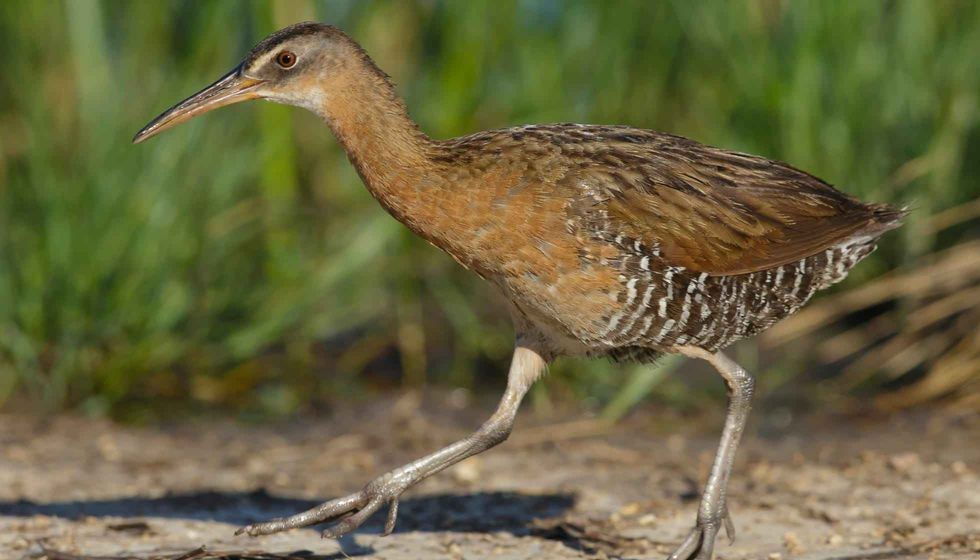This North American bird is called a king rail. A king rail (Rallus elegans) is a freshwater marsh bird with a medium-sized body.
They are a rusty color with spots on their side. These North American birds are generally found in coastal areas, grasslands, marshes, and even rice fields. Although king rails prefer freshwater marshes, they are often found using brackish wetlands.
They forage around shallow water and eat crustaceans and insects. For the construction of nests, a king rail bird prefers a raised platform built with marsh vegetation and uses a canopy to cover it. Their eggs are pale buff with brown spots.
After nesting, the chicks stay in the nest for about two months. The young ones, while staying in the nest, observe and learn from their parents.
King rails are considered to be game birds in the southern part of the United States. The conservation status of these birds is Near Threatened.
Keep reading to learn more facts about king rails. If you like reading about animal facts, do check out our articles on stork and limpkin.
King Rail Interesting Facts
What type of animal is a king rail?
A king rail is a type of bird, mostly found in North America.
What class of animal does a king rail belong to?
A king rail is a bird and it belongs to the class of Aves.
How many king rails are there in the world?
The exact number of king rails is not known.
Where does a king rail live?
A king rail is a North American bird that is mostly found in the southern part of the United States, especially in freshwater and saltwater marshes. They are permanent residents of the United States but a lot of them migrate to Mexico and Canada.
What is a king rail's habitat?
This species of bird is most commonly found in grasslands and savanna. They prefer coastal areas and brackish water. Water is extremely important to their survival as they dunk everything they eat in water before eating.
They prefer freshwater marshes but still use brackish wetlands. They are also found in rice fields in the United States. Grasses, rushes, sedges, and cattails are important for their habitat.
Who do king rails live with?
The social behavior of this bird is still not clear. However, they are said to be solitary in nature. Male birds are dominating and territorial. During the breeding season, all these birds are found in pairs.
How long does a king rail live?
The average life span of king rail living in marshes and brackish wetlands is five to nine years.
How do they reproduce?
King rails are a North American monogamous species of bird. Male birds are dominating, territorial and they display a lot of characteristics to attract a mate.
A lot of times, males gift females crabs and crayfish or send out mating calls. They are monogamous while mating but become solitary once this process is done.
The nesting season is from March to September. They make their nest using marsh vegetation on a high platform to protect it from predators. Once the mating process is done, females lay one egg at a time in the nest and they can lay six to 14 eggs in total.
The incubation period is about 22 days. Once the young ones are born, they start following their mother and take their first flight in about two months.
Both parents are involved in the nurturing of the young ones. Male birds, however, are more aggressive in their approach and defend the nest from any possible predators.
What is their conservation status?
According to reports from The International Union for Conservation of Nature Red List of Threatened Species, these birds are Near Threatened. Their population is decreasing.
King Rail Fun Facts
What do king rails look like?
King rails are the largest species of North American rails. The body structure of these birds is similar to that of a chicken and is a medium-sized marsh bird. They are slender and rusty in color, with long toes and bill.
Their upper body is olive-brown with a reddish breast, and their flanks are black and white. This species of birds has small tails. Males are often slightly bigger in size than females.
Chicks of king rails are black in color and are often confused with a black rail. However, their eyes are not red and they do not have spots on their body.
How cute are they?
King rails have a rusty appearance and their long toes and bill make them look scary.
How do they communicate?
This species of bird uses both sounds as well as visuals to communicate. They have a huge range of calls, but because they are secretive in nature, their behavior is not often understood. They make sounds such as 'chur-ur-ur' and 'kik-kik-kik'. During the breeding season, their vocalization increases. They also move their tail and make different postures for communication.
How big is a king rail?
A king rail length is in the range of 15-19 in (38-49 cm). It is about half the size of an average eagle.
How fast can a king rail fly?
The exact speed range of a king rail is not known. However, after nesting, they cannot fly for almost a month.
How much does a king rail weigh?
A king rail weighs around the range of 10-13 oz (283-369 g).
What are their male and female names of the species?
Male and female birds do not have separate names.
What would you call a baby king rail?
A baby king rail is called a 'chick'.
What do they eat?
A king rail (Rallus elegans) is an omnivore and mostly prefers crustaceans, insects (easily found near shallow water), and fish. They eat plants and seeds occasionally. Water is a crucial part of their diet because they immerse their food in it before consuming.
Are they dangerous?
Both adults and young ones are not considered to be harmful towards human beings in any manner. Therefore, they are not dangerous.
Would they make a good pet?
This bird species is generally not considered as a pet because of its lifestyle. They are territorial and dunk their food in water before eating. Their mating style is also slightly different as a male bird performs a 'pursuit display' to attract a mate. Also, their habitat range is best suited to a marsh.
Did you know...
After nesting, adult birds cannot fly for about a month until it molts completely. Molting is a process in which these birds shed their old feathers.
Where is a king rail native to?
King rails are native to the United States.
Why is a king rail endangered?
The main threat to the population of this species is habitat loss due to human activities. Although they are not endangered yet, they are facing a huge decrease in their population.
Here at Kidadl, we have carefully created lots of interesting family-friendly animal facts for everyone to discover! Learn more about some other birds including pitta bird, or red-tailed hawk.
You can even occupy yourself at home by drawing one on our stork coloring pages.










